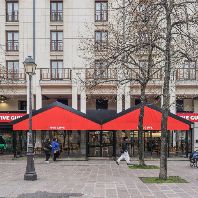Prime retail rents have fallen in almost every region across the world as the global recession impacts consumer sentiment and retail sales, according to new retail research from CB Richard Ellis (CBRE), Global Retail MarketView.
Demand for retail space has declined in most markets across the world as consumers cut back on spending and unemployment continues to rise in many countries. Emerging and less established markets have been most significantly affected. Buenos Aires saw the largest annual decline in retail rents year-on-year with a drop of 37%, followed by Warsaw with a 33% decline and Washington DC with a 26% decline. Whilst some markets have continued to experience year-on-year increases in retail rents, in many cases the current pressure is downward.
Prime retail rent represents a typical open-market headline rent that an international retail chain can expect to pay for a ground floor retail unit (either high street or shopping center depending on the market) of the highest quality space in the best location in a given market.
Despite a 10% year-on-year rental decline, New York remains the world's most expensive retail destination, with rental values totaling US $1,800 ft²/annum. New York's retail rents stand at nearly double those of Hong Kong, which still ranks in second place globally with rents of $975 ft²/annum. In an interesting switch, Moscow has superseded Tokyo in the ranking, moving into third place from fourth, followed by Paris and Tokyo respectively, making up the top five most expensive retail locations.
Nick Axford, Head of EMEA Research and Consulting, CB Richard Ellis, commented: "With unemployment rising and consumer confidence and spending weakening across most parts of the world, most retail property markets are experiencing reduced demand from retailers and an increase in the number of vacant units, which is in turn affecting rents.
"Some retailers are using this as an opportunity to take advantage of the weakening market conditions to negotiate more favorable lease terms. Landlords are keen to avoid vacancies, and in some circumstances this makes them more willing to compromise with tenants who are in a position to leave. However, landlords are tending to hold firm on the best space in the belief that any empty shops will be quickly taken up. More profitable retailers are actually jumping on rare opportunities to move into prime units whenever vacancies emerge in top high street locations," Axford added.
Europe, Middle East & Africa
Moscow, Paris and London (respectively) top the retail rents ranking in the EMEA region, with Moscow now the third most expensive market in the world. The threat of weaker demand and rising vacancies caused the EU-27 Retail Rent Index decrease by 3% during the first quarter of 2009, a decline of 1.2% year-on-year. The rate of European rental growth has been steadily declining since peaking at around 5% quarter-on-quarter in mid-2007. Prime retail rents fell by 10% or more quarter-on-quarter in several markets including Dubai, Barcelona, Athens and Dublin. Retailer demand is down in most EMEA markets but there are some bright spots, as many discount and food retailers have announced major expansion plans. In some markets, retailers are also known to be negotiating with landlords to secure rent discounts or more favorable lease terms in exchange for agreeing to extend their leases.
Americas
US cities continue to lead the most expensive retail rents in the Americas region. Los Angeles and San Francisco rank at ninth and tenth positions within the global ranking, following New York as the most expensive destination in the world. Yet with vacancy rates for all property types continuing to increase in the US, the first signs of rental decreases have been seen across most key American cities in the first quarter of 2009. Retail spending has been fluctuating in Latin American countries, and retail rents in the region have been affected to varying degrees, with Mexico City and Buenos Aires seeing retail rents fall by 14% and 37% r












